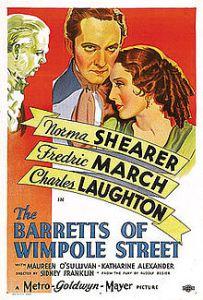Sonnet (number XLIII) by Elizabeth Barrett Browning
How do I love thee? Let me count the ways. 
I love thee to the depth and breadth and height
My soul can reach, when feeling out of sight
For the ends of Being and Ideal Grace.
I love thee to the level of everyday’s
Most quiet need, by sun and candlelight.
I love thee freely, as men strive for Right;
I love thee purely, as they turn from Praise.
I love thee with a passion, put to use
In my old griefs, and with my childhood’s faith.
I love thee with the love I seemed to lose
With my lost saints, – I love thee with the breath,
Smiles, tears, of all my life! – and, if God choose,
I shall but love thee better after death.
I did mention yesterday that I was thinking of choosing one of Shakespeare’s sonnet’s before opting for some verses from a play, so today I have indeed given you a sonnet. This one by Elizabeth Barrett Browning (1806-1861) was originally written in 1845 and published in 1850 as part of a collection called Sonnets from the Portuguese. I have taken the sonnet from the small but beautifully chosen anthology published by Penguin Classics (2009) and selected by Laura Barber that is pictured above. I think I bought this originally as an ideal traveling companion as it is neat enough to fit in pocket or bag.
Elizabeth Barrett had been writing and translating poetry and essays for several years before she was introduced to her future husband Robert Browning in 1845, who later persuaded her to publish her love sonnets. My first awareness of Barrett Browning had been though the story of the couple’s love affair and elopement which was set against a background of parental disapproval and Barrett Browning’s invalid status. The film The Barretts of Wimpole Street (1934 version) made a great impression on me, as Charles Laughton was so terrifying as Mr Edward Barrett. All this for me, initially overshadowed her values and achievements. She wrote in support of the anti-slavery movement (her family money came from Jamaican plantations) and also of child labor reform legislation. By the time Robert Browning asked to be introduced to her, she was a very well-known and critically acclaimed writer.
If you want to know more about Elizabeth Barrett Browning’s life and work I can recommend a biography by Margaret Forster (1989) and also Lady’s Maid (1990) in which Forster went on to explore the life of Barrett Browning’s devoted maid Lily Wilson. For something more unusual, but well worth reading try Virginia Woolf’s Flush: a biography (1933) told from the point of view of Barrett Browning’s pet dog which was given to Elizabeth by the writer Mary Russell Mitford. Finally, I have discovered that there is a Browning Society which promotes and discusses the work of both of the writers.

More tomorrow!
(Film poster taken from Wikipedia)

